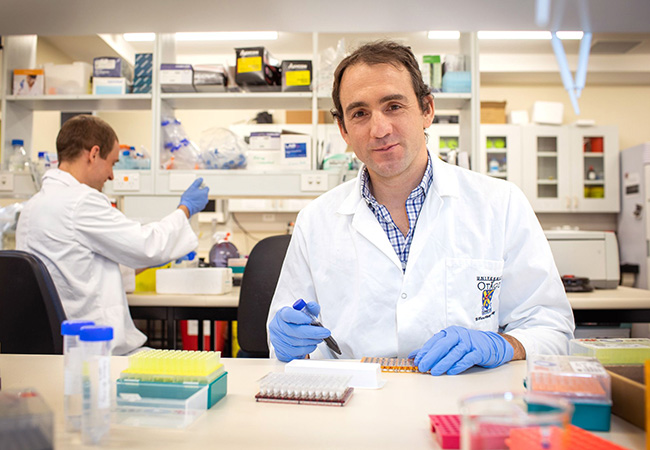
Dr Tim Hore (right) and his PhD student Tim Moser continue to work in their lab on their diagnostic test for COVID-19 which has had huge uptake internationally. Photo credit: Sharron Bennett.
A method to help improve testing for COVID-19, first promoted by a University of Otago researcher, is being used worldwide as countries struggle to manage high demand for testing.
In early 2019, Drs Tim Hore (Otago) and Tomasz Jurkowski, from the University of Cardiff showed scientists how to purify genetic material from a wide range of sources using self-made magnetic nanoparticles for use in research and testing.
They called the platform: “Bio-on-Magnetic-Beads” or “BOMB” for short and originally advocated the “do-it-yourself” system on the basis that it was much more cost-effective and flexible than existing solutions for purifying genetic material. It could also be scaled for processing hundreds of samples simultaneously using robotic instruments.
Fast-forward to March 2020 and a few days prior to New Zealand's move to “lockdown”, Dr Hore was contacted by Canterbury Health Laboratories (CHL) Scientific Officer, Dr Kylie Drake, a University of Otago alumna, who was actively looking for ways to purify the genetic material from the COVID-19 virus, so that it could be tested for diagnosis.
Dr Hore explains that usually this is done using reagents supplied in a proprietary kit sold to testing laboratories. “This works fine under usual circumstances, but we now know that when a pandemic like this hits, companies are unable to keep up with demand, panic-buying occurs as countries try to secure testing for their people – and inevitably stocks run out.
“Because of the limited reagent supply from companies and precipitous drop in air-travel it was harder and harder to get the required reagents in and New Zealand's ability to test for COVID-19 testing was severely threatened.”
Dr Hore adapted one of the protocols to isolate genetic material from the SARSCov-2 (COVID-19) virus. Dr Drake undertook all of the testing and validation required to make this a diagnostic test, so it was proven to work well in a clinical setting and as such could be implemented widely if needed.
Dr Hore explains it resulted in a locally-developed, efficient and validated diagnostic method to purify the genetic material of the virus that did not rely upon foreign life-science companies for supply.
“It gave District Health Boards a backstop, so that if the supply chain for reagents failed, we were still going to have a method to purify the genetic material from the virus so that it could be tested in patients.”
Fortunately however, the supply-chain has held up in New Zealand so the protocol has only been used in limited capacities, testing some frontline healthcare workers that needed rapid turnaround.
Instead, the biggest impact of the work has been outside of New Zealand. Drs Hore and Drake published their protocol on the BOMB.bio website on 4 April and international interest has been steady since.
“Researchers and clinicians from at least West Virginia and Oklahoma in the US, Cardiff, the Isle of Man, London, Norway, Estonia and Colombia are either using this protocol or modified BOMB protocols to undertake COVID-19 research or to do diagnostic testing,” Dr Hore says.
“We have also been invited by the UK's National Health Service COVID-19 Novel Testing Solutions Team to participate in web calls to improve resilience in diagnostic testing and there is even a team implementing mobile testing facilities from shipping containers (OpenCell London) that uses our method.”
Dr Drake emphasises the protocol would not have been used in New Zealand if it were not for Dr Hore.
“Several of us were given the remit of finding an alternative RNA extraction method that used reagents we could readily source within New Zealand. I crowdsourced the issues on Facebook, by email to colleagues overseas and within New Zealand and out of all of them, Tim was the one who stood up and said 'let's do this!'.”
Infectious disease specialist, Professor David Murdoch from the University of Otago, Christchurch, explains Dr Hore's method is a useful alternative to other standard methods, especially at a time when lab supplies were running short globally.
“Fortunately, New Zealand got on top of the pandemic quickly, so it wasn't needed here, but the situation could have been different had we had the large number of cases that some countries experienced.”
Needless to say it has made for a busy time for Dr Hore and he pays tribute to his PhD student, Tim Moser – “who has been working day and night in the laboratory for weeks now refining synthesis of the paramagnetic beads.
“If required, he could produce enough reagents to purify the virus from more than 40,000 people per day – a tremendous achievement.”
Dr Hore also credits BOMB.bio co-founder Dr Jurkowski for developing the system further and pushing for diagnostic testing at his base in Cardiff and more broadly, the UK.
“Tomasz has already significantly streamlined the protocol and has very quickly started to process many samples per day – with the aim to become thousands soon.”
Dr Hore says he is humbled by the impact of the work. “Tomasz and I started this work for purely academic reasons and to save money as we were establishing our laboratories, so it is very humbling to see it have direct relevance to New Zealand diagnostic testing and to now be used fighting COVID-19 worldwide.”
For further information, contact
Dr Tim Hore
Department of Anatomy
University of Otago
Email tim.hore@otago.ac.nz
Liane Topham-Kindley
Senior Communications Adviser
University of Otago
Tel +64 3 479 9065
Mob +64 21 279 9065
Email liane.topham-kindley@otago.ac.nz
Find an Otago expert
Use our Media Expertise Database to find an Otago researcher for media comment.